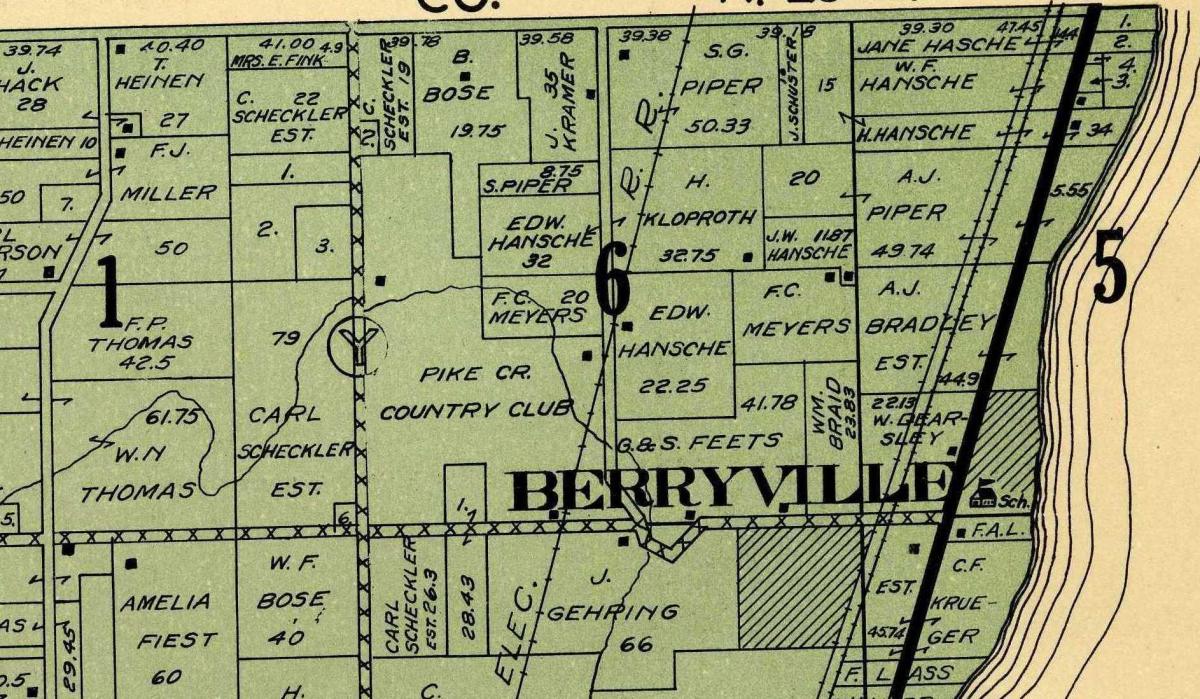Location
The Town of Somers had several clusters of sub-communities within itself. One, Berryville, was located in the northeast corner of the Town, bordered by the eastern shores of Lake Michigan. The “center” of the community settled near the intersection of Highway 32 and Highway A (Berryville Road).

Partial 1927 Map of Town of Somers, Kenosha County
History
Native Americans
When European settlers began to arrive in the Town of Somers in the early 1830’s, Native American peoples lived in this area, primarily the Potawatomi Tribe. Most farmers in the Town have an “arrowhead” collection; however, many of the arrowheads and spearheads were found around key hunting areas such as small streams, Pike River, and the shore of Lake Michigan. Arrowheads and spearheads recovered in the Berryville area document a long period of Native American habitation in the area.
Hardin Barbed Projectile Point (Paleo-Indian Period 10,000 – 8,500 BC) found on the Klapproth Farm, Somers, Kenosha County
©2013 Jacqueline Klapproth Nelson. All Rights Reserved.
Godar Projectile Point (Middle Archaic Period 6,000 – 3,000 BC) found on the Klapproth Farm, Somers, Kenosha County
©2013 Jacqueline Klapproth Nelson. All Rights Reserved.
Madison Triangular Projectile Point (Late Woodland Period 400 – 1,100 BC) found on theh Klapproth Farm, Somers, Kenosha County
©2013 Jacqueline Klapproth Nelson. All Rights Reserved.
Settlers and Farming
The first Berryville European settlers, largely from Scotland, Germany, and New England, came in the early 1840’s. A strip of about two miles wide along the shore of Lake Michigan was formerly under the water of the lake when it was about 40 feet higher than it is now. The strip is nearly flat and the soil is largely sand and sandy loam making it prime productive agricultural land. This is where most of the truck farmers were located. Truck farmers in Berryville were exceptionally successful growing cabbage, onions, sugar beets and strawberries, crops that thrived growing in sandy soil and a moderate lakeside temperature. Berryville was named for the abundant amount of strawberries grown in the area.
Railroads
Also important to the development of Berryville were two north-south railroads. They were available to ship farmer’s crops to both the Chicago and Milwaukee markets. This made transportation easy, economical, and fast, which was critical for crops, especially perishable crops like strawberries and summer vegetables. The most easterly railroad was the Chicago and Milwaukee (built in 1855) which became part of the Chicago Northwestern system. About a mile to the west, the North Shore Railroad, mainly a commuter railroad, made Berryville stops at County Line Road, Hansche/Klapproth driveway, Kenosha Country Club, Berryville Road, Bose driveway, and Birch Road.
The Community
The community of Berryville quickly grew due to the success of truck farming. The first Berryville School was built of logs on the Hansche farm in 1855 and the second school was built about 1872 on the east side of Lake Shore Drive (now known as Highway 32). In 1923, over 300 residents in the Berryville School district voted to erect a new modern schoolhouse on the west side of Lake Shore Drive at the intersection of Highway A or Berryville Road.

The first Berryville School built in 1855, John Hansche farm, Somers, Kenosha County
©2013 Jacqueline Klapproth Nelson. All Rights Reserved.
A Berryville Depot was built on the Chicago and Milwaukee Railroad which included a Post Office and Berryville Postmaster. Berryville Methodist Church, built in 1899 had 110 members and in 1859 Congregational church services were held in the Berryville School. Social and church groups often held picnics at Piper’s Park and Krueger’s Grove, both located on Lake Shore Road. In the 1930’s an Old Time Dance Club was located on Lake Shore Road, Berryville School had an active Mother’s Club, and the neighborhood had many social card club groups that met to play the then popular game of Bunco. In the early 1920’s Kenosha Country Club was built on 13th Avenue.

Berryville Depot on the Chicago and Milwaukee Railroad (looking north on Berryville Road/Highway A, Somers, Kenosha County)
The Depot also housed the Berryville Post Office
©2013 Jacqueline Klapproth Nelson. All Rights Reserved. Photo courtesy of Warren and Lyla Kramer.

Berryville Methodist Church, circa 1899, Somers, Kenosha County
©2013 Jacqueline Klapproth Nelson. All Rights Reserved. Photo coutesy of Warren and Lyla Kramer.
Today
Today, there is little remaining to remind people the community of Berryville existed. Small family farms with tilled fields, farmhouses, and wooded areas continue to dot the landscape while summer cottages built years ago on the lakeshore are being renovated or replaced with new modern homes. The North Shore Railroad is now a popular paved multi-use rail trail. The Berryville area continues to be primarily a rural single family neighborhood with a few commercial areas scattered along Highway 32.
(Source: Written by Jacqueline Klapproth Nelson)



